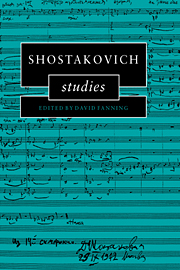Book contents
- Frontmatter
- Contents
- Acknowledgments
- 1 Introduction. Talking about eggs: musicology and Shostakovich
- 2 Public lies and unspeakable truth interpreting Shostakovich's Fifth Symphony
- 3 Form in Shostakovich's instrumental works
- 4 Russian theorists on modality in Shostakovich's music
- 5 The cycle of structure and the cycle of meaning: the Piano Trio in E minor, Op. 67
- 6 Leitmotif in Lady Macbeth
- 7 From Lady Macbeth to Katerina Shostakovich's versions and revisions
- 8 The Golden Age: the true story of the première
- 9 ‘And art made tongue-tied by authority’ Shostakovich's song-cycles
- 10 A debt repaid? Some observations on Shostakovich and his late-period recognition of Britten
- 11 Shostakovich and Schnittke: the erosion of symphonic syntax
- Index
10 - A debt repaid? Some observations on Shostakovich and his late-period recognition of Britten
Published online by Cambridge University Press: 22 October 2009
- Frontmatter
- Contents
- Acknowledgments
- 1 Introduction. Talking about eggs: musicology and Shostakovich
- 2 Public lies and unspeakable truth interpreting Shostakovich's Fifth Symphony
- 3 Form in Shostakovich's instrumental works
- 4 Russian theorists on modality in Shostakovich's music
- 5 The cycle of structure and the cycle of meaning: the Piano Trio in E minor, Op. 67
- 6 Leitmotif in Lady Macbeth
- 7 From Lady Macbeth to Katerina Shostakovich's versions and revisions
- 8 The Golden Age: the true story of the première
- 9 ‘And art made tongue-tied by authority’ Shostakovich's song-cycles
- 10 A debt repaid? Some observations on Shostakovich and his late-period recognition of Britten
- 11 Shostakovich and Schnittke: the erosion of symphonic syntax
- Index
Summary
In the Red House at Aldeburgh hangs a portrait of Anton Del'vig, the poet to whom are addressed the lines by the Decembrist, Wilhelm Küchelbecker – lines set by Shostakovich in his Fourteenth Symphony, the work he dedicated to Benjamin Britten in 1969. A gift from Shostakovich to Britten, the portrait would seem to lend confirmation to what is surely implicit in the ninth movement of the symphony: that those lines of Küchelbecker served Shostakovich as a mouthpiece for a fraternal greeting to his English friend and colleague. In the desolate context of the symphony this setting stands apart on account of its emotional warmth and tonal stability; indeed, its calm, hymnal gesture of four luminous triads that dispel the angry twelve-note ‘cluster’ of the previous movement could almost be taken as a friendly salutation à la manière de Britten. and the key – Db major – is the key of ‘the world of high ideals’ in Shostakovich's Twelfth String Quartet:
O Delvig, Delvig! What reward
for lofty deeds and poetry? …
Immortality is equally the lot
of bold inspired deeds
and sweet songs!
Thus will not die our bond,
free, joyful and proud!
In happiness and in sorrow it stands firm,
the bond of eternal lovers of the Muses.
The high seriousness and cyclic sense of completion that Shostakovich brought to his work in the final years of his life coincide with an on-going, passionate admiration for Britten and his music, whose own accomplishments during the same period (the composers died within a year of each other) correspondingly proclaim a late, valedictory style.
- Type
- Chapter
- Information
- Shostakovich Studies , pp. 229 - 253Publisher: Cambridge University PressPrint publication year: 1995
- 2
- Cited by



